THE EYE IS AN ORGAN that can be trained. It can be taught to see whale spouts or arrowheads or lobster antennae.
Passion is what trains the eye, and Ancil Jacques’ passion is mushrooms. This obsession takes him deep into the wildest woods, roving his trained and hungry eyes over shadowy, undisturbed ground.
Except it’s not really mushrooms he’s after.
From the time he was a boy growing up in Dixie Union, Georgia, Ancil was looking for something more, something out beyond industry, out beyond a good lawyering job, out beyond protocol.
When I met him, I thought, Damn, I think he’s found it.
This essay published in Gravy, the journal of the Southern Foodways Alliance. Chanterelle season has just begun in the southernmost states.

🍄
Ancil’s a tall guy, about thirty, loose in his musculature, his long brown hair twisted into a power-bun. He studies mushrooms, identifies them, hunts them, grows them, experiments with them. “I’m just a fun-gi,” he’ll joke. He moved to my village years ago when his fiancée (now wife) got a job teaching science at the middle school.
Until Ancil, I never met anybody in south Georgia who thought about mushrooms. Sure as heck they didn’t go poking around the woods for them. If they went to the woods, they wanted to come out with a turkey or a big buck. Every mushroom hunter I’ve ever known lived somewhere else—morel-seekers in the Appalachians, or Trudy Crites in Vermont, who learned to identify mushrooms when she was a dark-haired child in Germany.
For most people, mushrooms are about food. For Ancil, it’s something else.
🍄
One morning I hear our farm gate clang. I look out the kitchen window to see Ancil driving in. It’s a Tuesday, cloudy so it seems earlier than 8:30, and cool for late July. It’s going to rain, like every day for the past month. Ancil gets out of his truck, in his usual outdoor shorts, dark tee, and Crocs. He’s carrying a woven harvest basket.
I grab a pad and pen and rush out.
“Want to cruise along?” he asks. I have never seen him anything but upbeat, eager, buoyant.
“Finally,” I say. For months I’ve been hankering to shadow Ancil. I’ve wanted to write about him. And learn a little about mushrooms.
A red gate leads from our yard to the cow pasture, which must be crossed to get to our woods.
“Foraging was badass yesterday,” Ancil says. “I got twenty-four pounds of multiple species. Mostly chanterelles.”
Out of the corner of my eye I see our mule, also badass, look up at the clatter of the gate. Ancil can’t forage our pasture without the mule tagging him.
There are multiple species of chanterelles, Ancil tells me. All of them are golden or yellow, but on the underside of the caps, where the gills would be, some are smooth and some are ridged.
“Remind me what a gill is.” The lexicon of fungi is a dark universe to me.
Ancil says gills are the diaphanous tissues on the underside of the cap, radiating out from the stalk, where spores are produced. All chanterelles have false gills, so he uses the word “ridges” instead of “gills” for them.
The mule is coming at a trot. “The two kinds,” I say. “What’s the diff?”
“Smooth, lateritius, are cleaner, more robust, more resilient, with shallow ridges. Little cibarius are soft and fragile as compared to smooth, with more defined ridges.” That’s the way he talks, endearingly—“little cibarius.”
At the edge of the woods the mule catches up. Tecumseh’s like a really big dog but without the love. That’s how we enter the woods, a longhair with a basket looking for something that can’t fill a basket, a woman who wants the story, and a disrespectful red mule.
Ancil strides past a white pop-up. “Puffball,” he says. “You could eat them but I’m not gonna.”
“Why not?”
“Why eat puffballs when you have chanterelles?” He shifts the basket away from the mule.
Pretty soon we’re seeing chanterelles under the draping limbs of live oak. Ancil starts picking. Tecumseh sniffs at the basket.
“How did you get going on all this?” I ask.
“When I was a little kid I liked mushrooms,” he says. “I liked picking mushrooms and throwing them against trees. Mushrooms are endlessly cool.”
Mushrooms are enchanting. They appeared magically after a rain and then just as magically disappear. They are the work of fairies, who dance around fairy rings at night. Little people use them for shelter during storms. Leprechauns slide down their caps.
By the time Ancil was sixteen he had discovered psychedelic mushrooms in the fields around Dixie Union. Or thought he had. What he really was gathering was a species of portobello, but he didn’t know better.
Long ago I had brought up the subject of psychedelics with Ancil—everybody does—and he had seemed dismissive, almost hurt. “Yeah, people always think that’s what I’m after,” he said.
Overhead, the sun breaks though gray matter. Now we pass out of the patch of chanterelles and keep walking the treeline, scanning the ground. Mushrooms are plentiful, and when Ancil sees one his eyes, like a pair of lasers, skim mosaics of grass and leaves and weeds.
“Look at these cool Boletus,” he says. I glance around for rattlesnakes before I move closer. The eye can be trained to see rattlers, too, although a couple of weeks ago my daughter stepped past a six-foot rattler before she saw it.
“Can you eat Boletus?”
“I wouldn’t.”
He’s heading toward a patch of slash pine between the marsh and the road. “I collected a stinkhorn one time under those pine trees,” Ancil says. “I never found the name for it.”
“You think it’s a new species?” I asked.
“May be.”
🍄
Of all the dominions of life, mushrooms have the coolest names. In the Boletus genus, for instance, there are shaggy-stalked, red-cracked, king. Some are named for their associated trees and among the boletes alone you find chestnut, rosy larch, bay, and ash-tree. Puffballs are named skull-shaped, gem-studded, purple-spored, orange-staining. The cool names come dancing—earthstar, dunce cap, chicken of the woods, jelly roll, pig’s ears, poison pie. Purple jelly drops, stalked hairy fairy cup, swamp beacon.
🍄
One year to celebrate his birthday Ancil organized a mushroom hike for close friends. Ancil was born in December, when oyster mushrooms are fruiting. We met in a clearing at Big Hammock Wildlife Management Area (WMA) in Tattnall County, Georgia. Ancil’s soon-to-be wife, Sarah Willis, a blond and small-boned schoolteacher, was there, as was his pretty, athletic mother.
The trail wandered off through a Pleistocene sandhill that had evolved into a deciduous forest. The oysters would be deeper in the woods.
Problem was, between the clearing and the oysters were scores of fungi, each beautiful, mysterious, and mesmerizing. Ancil knew for each of them a Latin binomial, a common name or two, and some stories.
Mushrooms are one of the major categories of life on earth, as Ancil says. Yet they mostly go unnoticed. That’s because the majority of the mushroom world is underground in a huge mycelium network of thin threads—visible filaments—called hyphae. The hyphae surround tree roots, acting as root extensions, taking nourishment from the tree and obviously giving something back although we don’t know exactly what. Every tree has its own mycelium network and those networks intermingle below ground, trees talking to trees through their phone lines.
The mushroom is the fruiting body, the sexual energy, of these reticulate strands.
That day in December, our party group was like a lumbering mammoth, pausing every few steps to see a new fungus—purple, polka-dotted, red, yellow-orange, black, phallic, melty, shelf-like. Then I saw my first oyster mushroom, white as a biscuit and growing right out of an oak. They’re named for how they look, pearly, not how they taste or smell.
Back at the trailhead Ancil hauled out his camp stove and some butter, birthday mushrooms. The books call them “choice.”
🍄
Ancil’s passion is contagious.
A few days later my husband and I went looking for oysters in our own woods, down by Slaughter Creek. We walked a long time, watching for snakes among dog hobble and bracken fern, then craning to see white splotches on trees. Leaves had fallen from the poplars and maples and some of the oaks, and their branches stuck gray and bare into a dreamy winter sky.
Here the woods are old-growth, and the blackwater creek, maybe ten feet wide, rushes through tupelo and magnolia on its way to the Altamaha River. On a fallen, sodden, mossy log that crossed the creek a raccoon had left small drifts of scat. A brace of wood ducks startled and flew riverward and a kingfisher nattered at us.
I’m going to tell you a secret. Oyster mushrooms are not hard to find. Once you finally spot what looks like a sponge cake up a tree trunk, you’ll see lots of cake. They grow high up and they grow low. Sometimes oysters grow on fallen trees.
That day we gathered bags full, probably ten pounds. Back home we emailed photos to Ancil.
“Jackpot!” he replied. “Sauté a batch in an iron skillet with butter. They’ll taste light and sweet, with willowy notes. Lay out the rest under a fan and let them dry. They can be dehydrated and stored.
We filled a number of gallon glass jars with dried oysters. Reconstituted, they turn rubbery and tough, but are perfect for broths and stock.
🍄
Likewise, once I could recognize chanterelles and knew enough not to confuse them with anything deadly, I was off like a cannonball. They flourish from June to October where we live. I walk my dogs down our dirt road and come home with enough chanterelles for breakfast in my shirt. The taste is delicate and sweet, with floral notes, fruity like apricot, slightly peppery.
🍄
I had lived my whole life in and out of south Georgia before I learned any of this. Without Ancil, I wouldn’t have known.
The woods were full of free food.
🍄
To turn his hobby into a job, Ancil built a mushroom farm. He has brought in a few shipping containers and installed shelves and added air-conditioning and found a guy who would sell him grow-blocks, squares of sterilized substrate, something like sawdust, inoculated with shiitake spores. Or oyster spores.
At first he stuck withy growing shiitakes and oysters. Then he started to grow lion’s mane, which, as it turns out, can help the brain regenerate cells.
Then he experimented with another medicinal mushroom called Cordyceps, used since ancient times in China and Tibet as a tonic for energy and endurance. He keeps growing, experimenting.
He sells at the Forsyth Farmers’ Market in Savannah, Georgia. Besides mushrooms, Ancil peddles mushroom salt, mushroom oil, grow-your-own kits, dried mushrooms, and mycelium-active potting soil (full of beneficial microorganisms).
Everybody knows Ancil as Swampy Appleseed, the mushroom guy. He gives talks at libraries and at schools, showing glorious pictures of mushrooms. “I cannot tell you how nice it is to say, I’m a mushroom farmer. I thought I’d be a college professor, at least a teacher. I had thought, I’ll teach kids how to read. But I’m not nearly as passionate about anything as I am about mushrooms.”
“Mushrooms allow me to live my life on my own terms,” he said. “They are my ticket to freedom. They give me independence. I don’t have to succumb to a nine-to-five job. Mushrooms allow me to hang out in the woods.”
🍄
Human activities like road-building and plowing and logging damage the vast underground networks of mycelium.
To find great mushrooms, therefore, you need old trees and big wild places. Our pasture is not productive enough because a hellishness of chemicals got dumped on it before we came along.
I asked Ancil if I could go with him on a serious forage.
We returned to the WMA. The regulations say we can gather mushrooms here for our own use.
It’s August and Big Hammock is steamy. I’m riding shotgun. We pass the firing range and the parking lot that shapeshifts into a huge encampment the night before deer season. Side roads have names like “Carter Wild Cow Road” and are posted with signs that read FOOT TRAVEL UNINVITED.
Up ahead a huge black boar arches into the roadway. “I spend thirty to forty hours a week here,” Ancil is saying. It’s a great place to work. But there can be some real-life trouble.” He’s speaking of the wild hogs, of course.
Also falling trees. “That’s probably the biggest danger,” Ancil says. “Widowmakers fall all the time. I’m just hoping never to be under one.” Once a tree crashed across an access road after Ancil had gone in and he had to call emergency rescue to chainsaw him out.
We have been driving slowly along a two-track road for over five miles through a vast floodplain, matted dark-brown leaves piling year after year on the ground, wet slicks in places, sunny sweeps of grass, cross vine and goldenrod. Watermarks from past floods girdle the gray bark of trees. The entire time, the chanterelle-seeker has been scrutinizing the forest floor. He wants it platinum-brown from weeks underwater. Finally, he parks.
“We have a good little vein here,” he says, handing me a basket.
Two days ago it rained, and now buttons, the name of young chanterelles, are springing up, knobby and contorted. They open into twisted urns that are firm and delicious for a couple of days until they begin to sag and fade.
Six hours later I’m beginning to be able, without Ancil’s help, to spot patches of the fleshy, orange, flowerlike mushrooms that have squeezed from underground and that will be gone in a week. They look like orange chalices, vase-shaped or sunken, a few drops of rain like chardonnay in their indentations.
“Every patch is beautiful and different in its own right,” says Ancil. A red-shouldered hawk files a report with the other hawks, charging us with trespass.
The object of foraging is to cover ground. “I do lots of zigzagging.” He says if you avoid spiders you add hours of travel time to your hike, since Georgia woods teem with spiderwebs. When Ancil comes upon a web, he rips down one foundation strand, never the whole thing, just enough to pass. Today I notice how the orbs are like mycelium in how ubiquitous they are, how they appear and disappear, how they feed something.
I’m hounding him, a few steps behind. Ancil has loaned me a shank made from a railroad spike and I’m clipping too, trying to keep dirt and duff out of my basket. I watch what he takes, trying to figure out why he chooses one mushroom over another. For me shelf-life doesn’t matter. By afternoon I’ll have these home. I plan to sauté some to freeze and also to dehydrate some for bone broths. Maybe I’ll pickle a few.
Ahead Ancil spots a white mushroom called a mock oyster. “But it can’t be confused on a plate,” he says. Real oysters are tender, not tough.
He shows me a bright-golden-yellow, drippy, slimy fungus growing on a fallen branch. He calls it tremella—witch’s butter—and says it can be eaten raw, which I do, peeling it off as if it’s a slug. It tastes earthy, oaky, with wheaty notes. It’s very chewy.
In the distance a rain crow plays its clackers.
🍄
As he describes it, Ancil had a storybook childhood, wanting to have fun but also to see deeply and to find meaning and have things make sense without getting too bent by them.
I ask about Dixie Union.
“When I was little, nothing was there,” he says. “We had gorgeous land, bluejack and live oak along Dryden Creek. The woods were this thing to do. When US 1 was four-laned, a gas station came along. Now there’s a Dollar General.” He says that even in Dixie Union a gang, the Dub, was operating, low-grade but dangerous. When he was thirteen, a kid about fifteen offered him meth. “I’m sure his life’s gone in a different direction,” he says.
Somewhere close by a limb cracks and smashes down.
“Looky here!” crows Ancil. “A honey mushroom.” A pitted, inky cap perches atop a thick stalk. Ancil says it’s edible, but he keeps moving. He’s after cibarius. “If it’s not orange, fuck it!” is actually what he says. I clip the honey and put it in my shirt pocket, stand up and take a spider web to the face.
Ancil walks into another thick patch of cibarius. One is poking out from a pile of washed-up debris. “I’ll leave that one for the snakes,” he jokes. Snakes don’t eat mushrooms, but they certainly hide in debris.
I’m realizing that foraging demands a mental energy I hadn’t considered. Ancil agrees. “You’re looking for yellow chanterelles and black bands of snakes. You’re scanning for wild hogs and checking the trees for widowmakers. You’re trying to stay oriented.”
He goes home tired but also not tired, he says, psyched by his great luck in life and by the pounds of loot that explode out of the ground, that need no cultivation, that are free for the taking, precious in the marketplace.
🍄
Ancil straightens. “Where’s our road?” It really is a question.
I twirl. The trunks of trees grow tall in the dim and lonesome woods in every direction of the compass. I feel as if I’ve been playing that kids’ game where you close your eyes while a friend spins you. When the whirling stops, you stumble
around trying to stay standing and figure out where you are.
A person can get very lost, looping in circles while foraging, avoiding webs, slapping bugs. The swamp is a crazy labyrinth. Often Ancil uses a map app on his cell phone, dropping a pin on his truck when he leaves it and consulting his phone when he needs to load up. Surprisingly the reception is usually good. When it’s not, he hopes to hear a gun at the firing range or a boat on the water.
After we’ve emptied our baskets once and gone back in, after we’ve knitted our way deep into the woods, skirting sloughs, he predicts we are near the river. He drags out his phone and locates the Altamaha a couple hundred feet away. It can’t be seen for tree cover.
“I’ve always experienced the woods, out hiking. But I’m different in the woods now.”
“How so?”
“I’m less wary, for one thing.” He pronounces it “weary.”
“Of what?”
“Pigs and snakes.” But there’s something else he’s trying to say. “I’m comfortable in the woods now. I’m part of them.” He keeps talking. “This is where I work. A lot of people confuse stress with work. There’s nothing unwholesome about this. It’s fun, unique, attractive, hyper-local. I really enjoy it.”
“Most of us are disassociated from the natural world,” he says. “What happens with mushrooms is that you reconnect to the world and you realize, Everything’s connected. You go around looking at things, saying, Look at this, this is part of the world.”
When he’s alone in the woods, Ancil tells me, he sings songs and babbles to the barred owls. “It’s nice to have you along,” he says to me. Through the woods, the cicadas drone as if they are meditating.
On the way back to the truck he steps over a beautiful white rosette, edged in gray. “Look at this Spongipellis,” he says. “Melt my heart.” As we pass a tree he spots volvariella emerging from bark, with a light pink, vulva-like veil. He points out Xylaria, dead man’s fingers, a club mushroom that liberates its spores when thumped, gust of smoke along a rotting log. He almost takes a reishi, a common shelf fungus that gets hard as clay, but decides it’s too old. Reishi, used as an antioxidant and a boost to the immune system, was one of the first mushrooms Ancil foraged. His folks add it to their coffee.
🍄
When we return to the clearing a wildlife officer is waiting, his DNR truck blocking both of our vehicles. I’m sure he thinks it’s a drug deal.
I walk to my car and pile my things on the trunk: notepad, camera, large bag of chanterelles. The officer is early thirties, in a uniform with a nametag, armed.
He asks us how we’re doing and then what we’re doing. I point to the mushrooms, visible through the bag. I’m so excited I’m kind of bubbling, like a shook-up bottle of club soda. Does the man realize that there are thousands of pounds of edible mushrooms scattered across the forest floor, throughout Georgia, and most people don’t know a thing about them?
“I don’t eat mushrooms,” the officer says. His dark hair is already thinning, but for now he is young and fit and cautious, even dangerous.
“Well,” Ancil says. Stops. There is so much to say.
Instead, I do the thing all Southerners used to do, which is to ask him where he’s from, which is where Ancil’s wife is from, and he knows her, and he lives where I’m from, and we know some of the same people, and after a while he knows we’re okay people, not running drugs, and he climbs back in his truck and eases on down toward the river to check fishing licenses.
🍄
I think that, finding mushrooms, Ancil has found something else, some amorphous spiritual thing that allows him to keep believing in goodness, believing in the natural world even with horrors like climate disruption, believing in people.
Because there’s another world. Most people won’t see it. It’s underground and aboveground, it’s fantastical and multicolored, it’s intimate and honest, it’s forgiving. It’s playful and poky and powerful. Call it whatever you want.
Ancil knows he wouldn’t have found it working in the lumber section of the building-supply store.
Of course, science keeps probing the universe, other planets, the black holes of our minds, our complicated bodies, ecosystems, the center of the Earth, the oceans. We search for life on Mars, for a cure for Alzheimer’s, for unheard-of species, for the tricks of DNA.
Even so, there remains some mystery we can’t touch, can’t recreate, can’t explain.
And surely, in that place, we find the most profound truths of all.
🍄
In the magical realism of the book Like Water for Chocolate, food is infused with the emotions that surround it. A wedding cake prepared while crying turns everybody sad. I think of that now.
When you eat Ancil’s chanterelles, you get Ancil’s joy and his gratitude, his effervescence. You get the knowledge that everything is connected to everything else and that you’re a part of it. And you get the place, too—the terroir.
You get the enchantment of a great serpentine expanse of blackwater floodplain, threaded with cypress sloughs and decades of organic matter from which crazily beautiful and puzzling things emerge. You get the falcate moon in a brilliant blue sky and the vivid greens of leaves, dramatic and flamboyant. You get spider lily. You get the nobility of owls and the enigma of yellow-billed cuckoos, cagey woods in all directions and nobody for miles. You get a wild boar crashing away and adorable wild piglets that halt and watch.
You get a place deep in the Georgia jungle that is covered with rainwater months of the year, and you also get an immense underground forest, an endless untrammeled network of fine lines that connect everything above with everything below.
You get, threaded throughout, a world you will never see.
Thanks to Sarah Camp Milam for wonderful editing on this piece, and many thanks to the Southern Foodways Alliance at the University of Mississippi for publishing it first. Thanks to Swampy Appleseed Mushrooms for the photography.

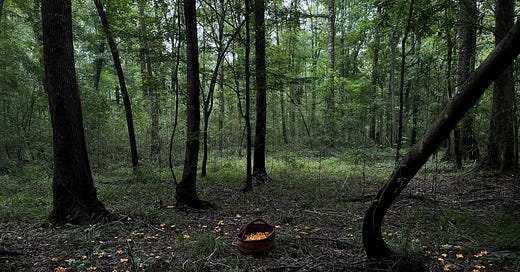


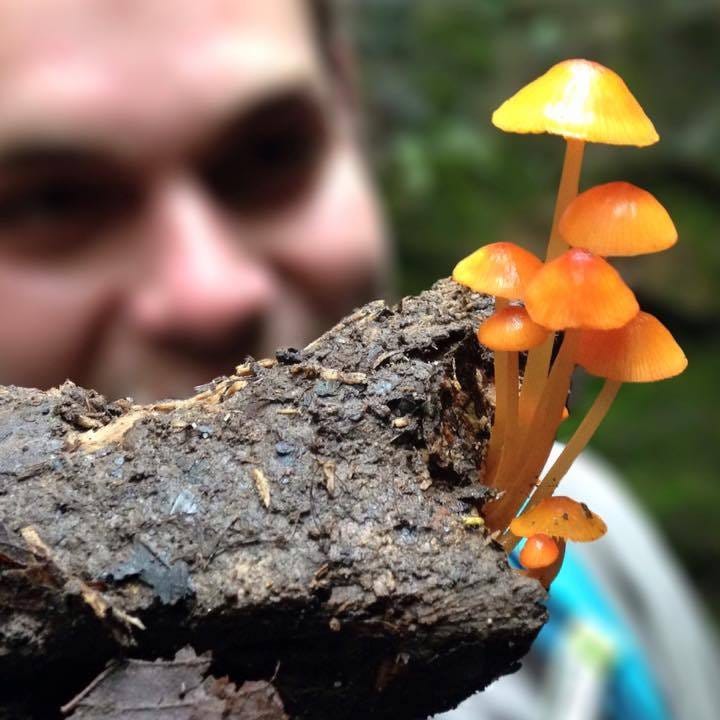
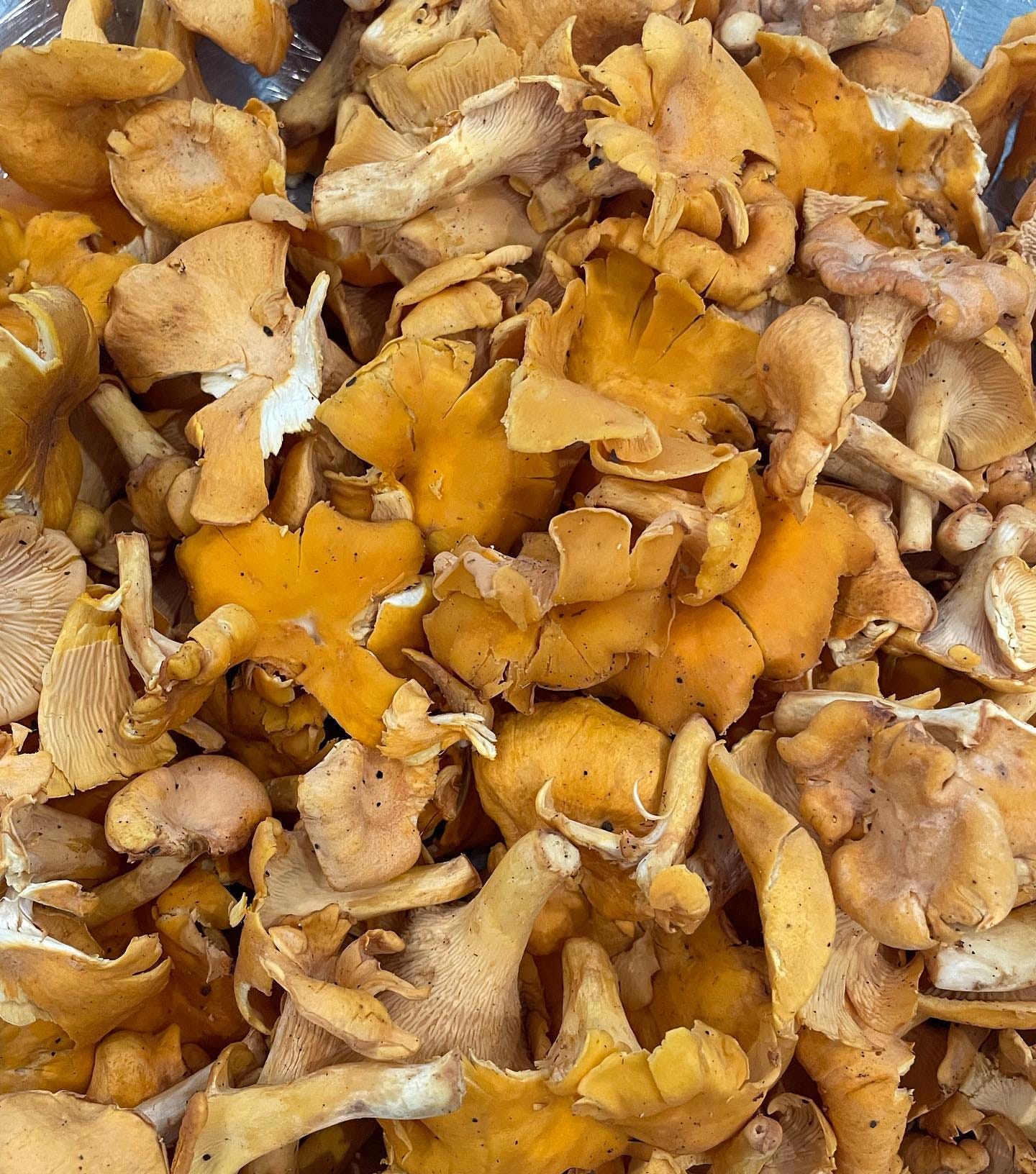
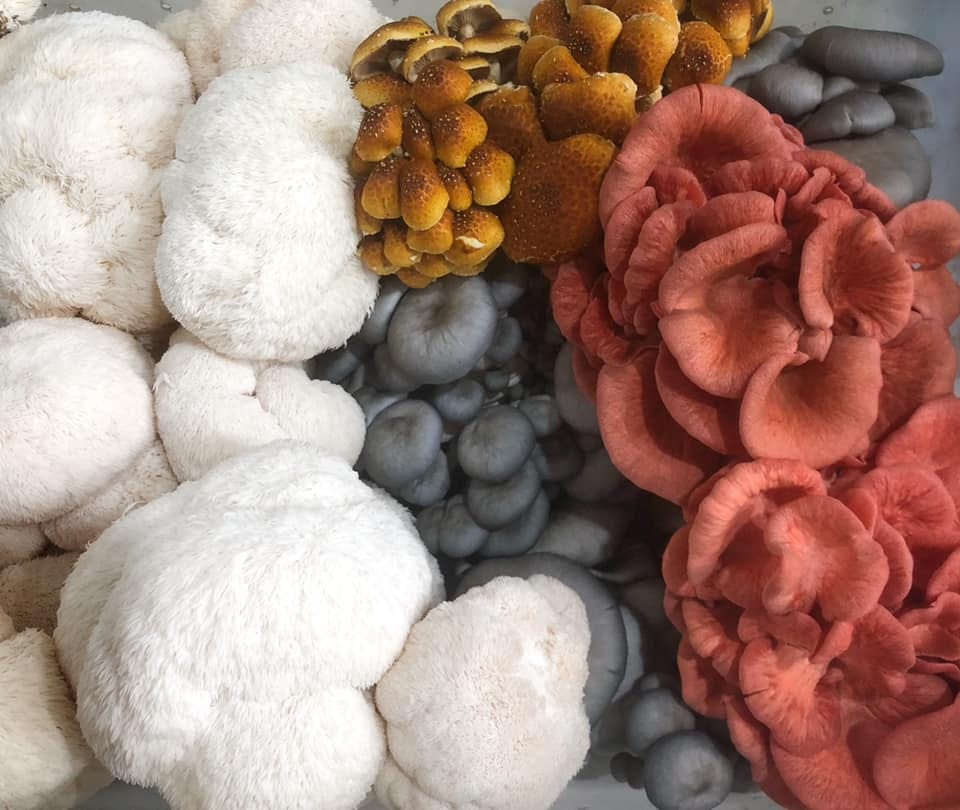
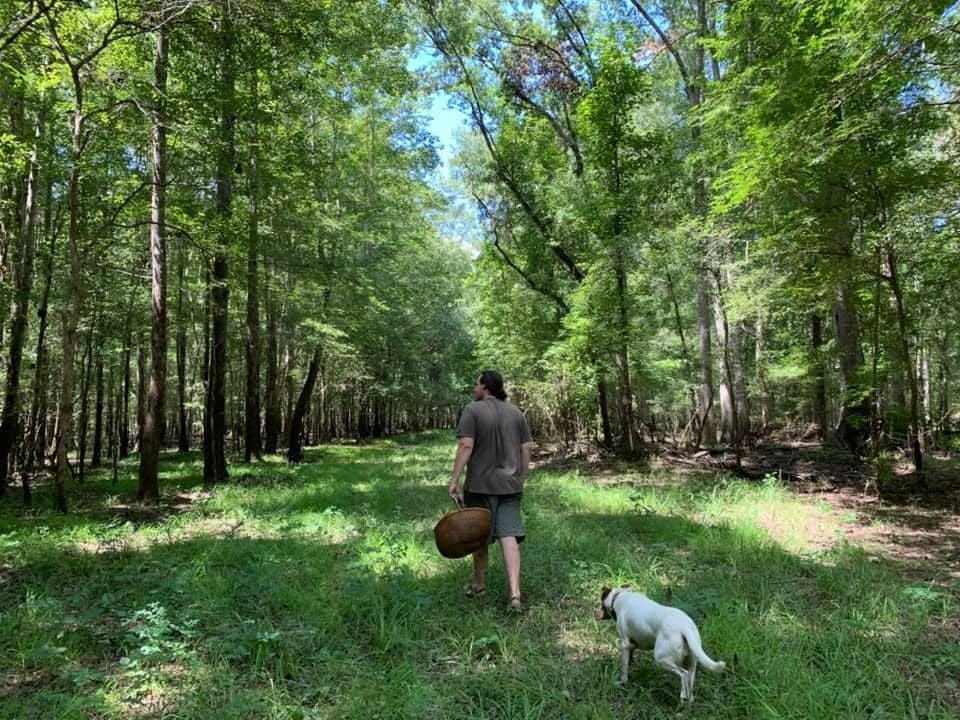


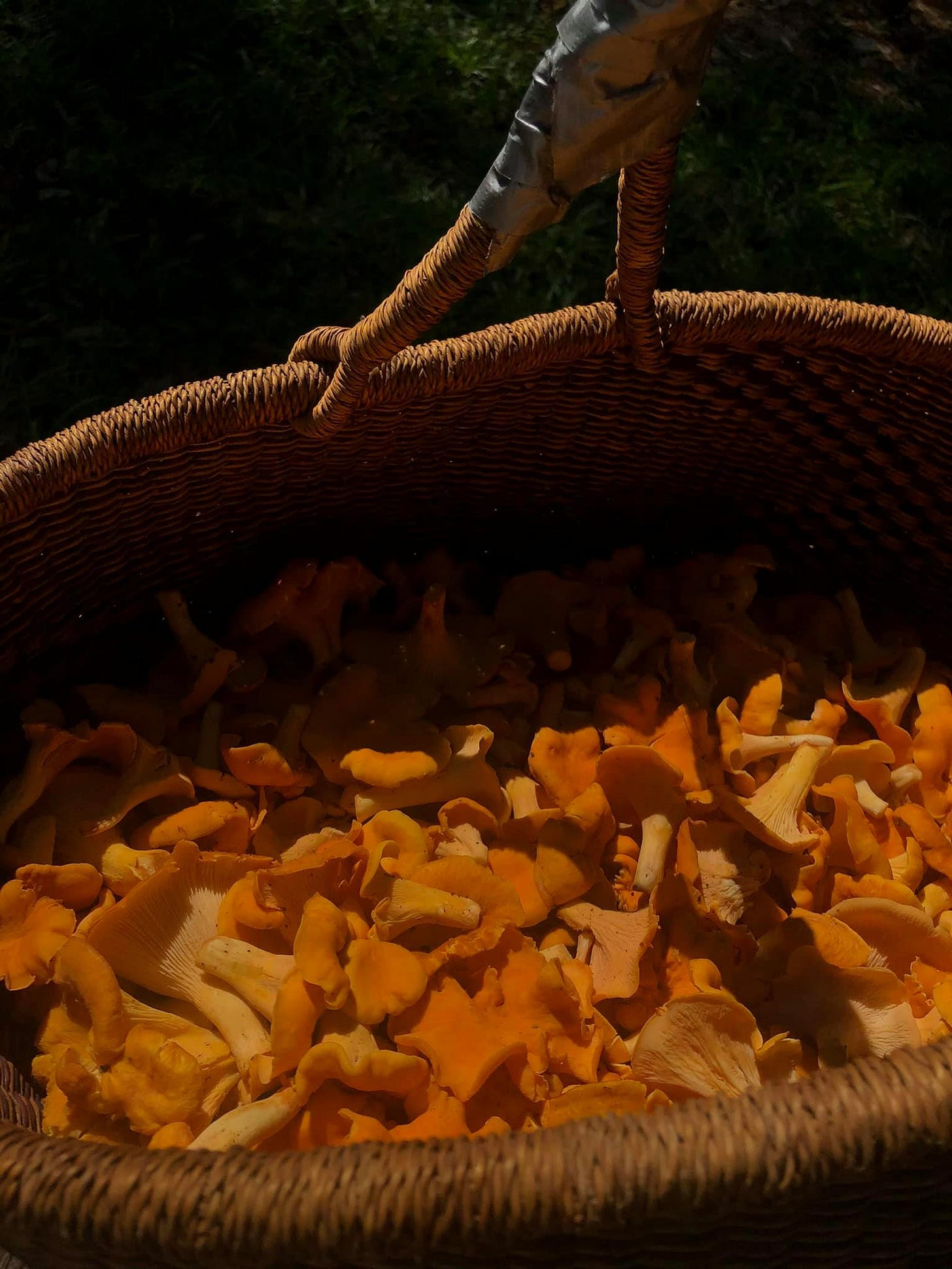
Hi Janisse,
I waited to read this essay until I could give it my full attention. And, I'm so glad I did. You take any topic and make it immensely interesting. Wild mushrooms are fascinating in their diversity of forms. Once on a night time adventure in a nature preserve, we observed a snail eating a mushroom. I was so enamored I have video. haha
Hi, Janisse. This is truly a beautiful piece. I wish I had met Ancil when I lived down there. I believed I left just as he moved there. Your descriptions of Bullard Creek brought back many good memories of exploring there on my own, all the warblers, cuckoos, water birds I saw there. I once stopped by there on my way home from a business meeting dressed in a business suit. A nice young man who was just putting his boat in invited me to come along and fish with him. I declined but always wish I had taken him up on it. I have so many fond memories of my time living there in such a beautiful place.